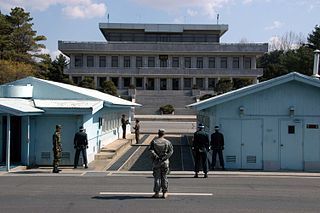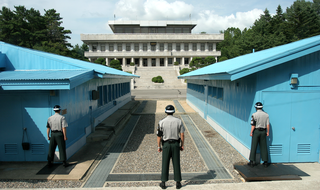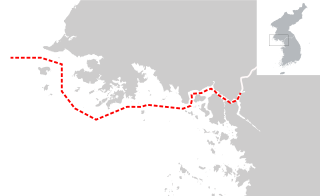| |||||
| Centuries: | |||||
|---|---|---|---|---|---|
| Decades: | |||||
| See also: | Other events of 1997 Years in North Korea Timeline of Korean history 1997 in South Korea | ||||
Events from the year 1997 in North Korea .
| |||||
| Centuries: | |||||
|---|---|---|---|---|---|
| Decades: | |||||
| See also: | Other events of 1997 Years in North Korea Timeline of Korean history 1997 in South Korea | ||||
Events from the year 1997 in North Korea .
1995~1999:Arduous March

The Korean War was an armed conflict on the Korean Peninsula fought between North Korea and South Korea and their allies. North Korea was supported by the People's Republic of China and the Soviet Union, while South Korea was supported by the United Nations Command (UNC) led by the United States. Fighting ended in 1953 with an armistice, with no treaty signed.

The division of Koreade facto began on 2 September 1945, when Japan signed the surrender document, thus ending the Pacific Theater of World War II. It was officially divided with the establishment of the two Koreas in 1948. During World War II, the Allied leaders had already been considering the question of Korea's future following Japan's eventual surrender in the war. The leaders reached an understanding that Korea would be liberated from Japan but would be placed under an international trusteeship until the Koreans would be deemed ready for self-rule. In the last days of the war, the United States proposed dividing the Korean peninsula into two occupation zones with the 38th parallel as the dividing line. The Soviets accepted their proposal and agreed to divide Korea.

The Korean Demilitarized Zone is a heavily militarized strip of land running across the Korean Peninsula near the 38th parallel north. The demilitarized zone (DMZ) is a border barrier that divides the peninsula roughly in half. It was established to serve as a buffer zone between the sovereign states of the Democratic People's Republic of Korea and the Republic of Korea under the provisions of the Korean Armistice Agreement in 1953, an agreement between North Korea, China, and the United Nations Command.

The Military Demarcation Line (MDL), sometimes referred to as the Armistice Line, is the land border or demarcation line between North Korea and South Korea. On either side of the line is the Korean Demilitarized Zone (DMZ). The MDL and DMZ were established by the Korean Armistice Agreement.

Located in the Joint Security Area (JSA), the so-called "Bridge of No Return" crosses the Military Demarcation Line (MDL) between North Korea and South Korea.

The Joint Security Area is the only portion of the Korean Demilitarized Zone (DMZ) where North and South Korean forces stand face-to-face. The JSA is used by the two Koreas for diplomatic engagements and, until March 1991, was also the site of military negotiations between North Korea and the United Nations Command (UNC).

The United States Forces Korea (USFK) is a sub-unified command of U.S. Indo-Pacific Command (USINDOPACOM). USFK was initially established in 1957, and encompasses U.S. combat-ready fighting forces and components under the ROK/US Combined Forces Command (CFC) – a supreme command for all of the South Korean and U.S. ground, air, sea and special operations component commands. Major USFK elements include U.S. Eighth Army (EUSA), U.S. Air Forces Korea, U.S. Naval Forces Korea (CNFK), U.S. Marine Forces Korea (MARFORK) and U.S. Special Operations Command Korea (SOCKOR).

The Northern Limit Line or North Limit Line (NLL) – 북방한계선 – is a disputed maritime demarcation line in the Yellow (West) Sea between the Democratic People's Republic of Korea (DPRK) in the north, and the Republic of Korea (ROK) in the south. This line of military control acts as the de facto maritime boundary between North and South Korea.

The Battle of Yeonpyeong took place between the navies of the Democratic People's Republic of Korea and the Republic of Korea on 15 June 1999, off the island of Yeonpyeong.

The Battle of Yeongpyeong was a confrontation at sea between North Korean and South Korean patrol boats along a disputed maritime boundary near Yeonpyeong Island in the Yellow Sea in 2002. This followed a similar confrontation in 1999. Two North Korean patrol boats crossed the contested border and engaged two South Korean Chamsuri-class patrol boats. The North Koreans withdrew before South Korean reinforcements arrived.

Australia entered the Korean War on 28 September, 1950; following the invasion of South Korea by North Korea. The war's origins began after Japan's defeat in World War II, which heralded the end to 35 years of Japanese occupation of the Korean Peninsula. The surrender of Japan to the Allied forces on 2 September 1945 led to the division of Korea into two countries, which were officially called the Democratic People's Republic of Korea (DPRK) and the Republic of Korea (ROK). The DPRK was occupied by the Soviet Union, and the ROK, below the 38th Parallel, was occupied by the United States (US).

The Pohang-class PCC is the low-end complement of the high-low mix domestic naval construction plan of the Republic of Korea Navy under the 1st Yulgok Project (1974-1986) for the Republic of Korea Armed Forces. It was originally planned as a Batch II production of Donghae-class corvette, but many changes on overall design, notably applying the hull design of Ulsan-class frigate, reclassified the ship to its own class. The ship is designed for patrolling maritime border, including the Northern Limit Line, protecting the littoral zone, and combating the North Korean vessels.

The 1998 Yeosu submersible incident was a naval skirmish that occurred off of the southern coast of South Korea between 17 and 18 December 1998. On the evening of 17 December, a South Korean observation post sighted a North Korean semi-submersible naval vessel in the vicinity of the city of Yeosu. The semi-submersible was discovered and sunk during a subsequent search and skirmish on the morning of 18 December.

The Daecheong incident, also known as the Battle of Daecheong, was a skirmish between the South Korean and North Korean navies near the Northern Limit Line (NLL) on 10 November 2009 off Daecheong Island.

The Battle of Taejon was an early battle of the Korean War, between U.S. and North Korean forces. Forces of the United States Army attempted to defend the headquarters of the 24th Infantry Division. The 24th Infantry Division was overwhelmed by numerically superior forces of the Korean People's Army (KPA) at the major city and transportation hub of Daejon. The 24th Infantry Division's regiments were already exhausted from the previous two weeks of delaying actions to stem the advance of the KPA.

The Battle of Sangju was an engagement between the United Nations and North Korean forces, occurring on July 20–31, 1950, in the village of Sangju in southern South Korea, early in the Korean War. It ended in a victory for the North Korean forces after they were able to push troops of the United States and South Korea out of the area.
Events from the year 1996 in North Korea.

After the Korean War, 333 South Korean people detained in North Korea as prisoners of war chose to stay in North Korea. During subsequent decades of the Cold War, some people of South Korean origin defected to North Korea as well. They include Roy Chung, a former U.S. Army soldier who defected to North Korea through East Germany in 1979. Aside from defection, North Korea has been accused of abduction in the disappearances of some South Koreans.